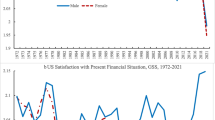Abstract
Although the greater longevity of married people as compared with unmarried persons has been demonstrated repeatedly, there have been very few studies of a comparative nature. We use log-linear rate models to analyze marital-status-specific death rates for a large number of developed countries. The results indicate that divorced persons, especially divorced men, have the highest death rates among the unmarried groups of the respective genders; the excess mortality of unmarried persons relative to the married has been generally increasing over the past two to three decades; and divorced and widowed persons in their twenties and thirties have particularly high risks of dying, relative to married persons of the same age. In addition, the analysis suggests that a selection process is operating with regard to single and divorced persons: the smaller the proportion of persons who never marry or who are divorced, the higher the resulting death rates.
Similar content being viewed by others
References
Baker, R. J., & Neider, J. A. (1978). The CUM Manual: Release 3. Oxford, UK: Numerical Algorithms Group.
Bishop, Y. M., Fienberg, S. E., & Holland, R W. (1975). Discrete Multivariate Analysis: Theory and Practice. Cambridge, MA: MIT Press.
Cox, P. R., & Ford, J. R. (1964). “The Mortality of Widows Shortly After Widowhood.” Lancet, 1, 163–164.
Fox, A. J., & Goldblatt, P. O. (1982). Longitudinal Study: Sociodemographic Mortality Differentials, Ser. LS, No. 1. London: Office of Population Censuses and Surveys.
Gove, W. R. (1972). “The Relationship Between Sex Roles, Marital Status, and Mental Illness.” Social Forces, 51, 34–44.
— (1973). “Sex, Marital Status, and Mortality.” American Journal of Sociology, 79, 45–66.
Grove, R. D., & Hetzel, A. M. (1968). Vital Statistics Rates in the United States 1940–1960. Washington, DC: National Center for Health Statistics.
Heising, K. J., & Szklo, M. (1981). “Mortality After Bereavement.” American Journal of Epidemiology, 114, 41–52.
Hu, Y.-H. (1987). “Patterns of Mortality Differentials by Marital Status in Low-Mortality Countries.” Journal of Population Studies, 10, 97–128.
Kaprio, J., Koskenvuo, M., & Rita, H. (1987). “Mortality After Bereavement: A Prospective Study of 95,647 Widowed Persons.” American Journal of Public Health, 77, 283–287.
Kiernan, K. E. (1988). “Who Remains Celibate?” Journal of Biosocial Science, 20, 253–263.
Kisker, E. E., & Goldman, N. (1987). “Perils of Single Life and Benefits of Marriage.” Social Biology, 34, 135–152.
Klebba, A. J. (1970). Mortality From Selected Causes by Marital Status: United States (Part B), National Center for Health Statistics, Ser. 20, No. 8b. Rockville, MD: U.S. Dept. of Health, Education, and Welfare.
Kobrin, F. E., & Hendershot, G. E. (1977). “Do Family Ties Reduce Mortality? Evidence From the United States, 1966–1968.” Journal of Marriage and the Family, 39, 737–745.
Koskenvuo, M., Kaprio, J., Kesaniemi, A., & Sarna, S. (1980). “Differences in Mortality From Ischemic Heart Disease by Marital Status and Social Class.” Journal of Chronic Diseases, 33, 95–106.
Koskenvuo, M., Kaprio, J., Lonnqvist, J., & Sarna, S. (1986). “Social Factors and the Gender Difference in Mortality.” Social Science and Medicine, 23, 605–609.
Levy, E. (1974). Données de démographie generale population totale mortalité, 1931–1971. Paris: Institut Nationale de la Statistique et des Etudes Economiques.
Livi-Bacci, M. (1985). “Selectivity of Marriage and Mortality: Notes for Future Research.” In Population and Biology, ed. N. Keyfitz. Liege, Belgium: Ordina Editions, pp. 99–108.
MacMahon, B., & Pugh, T. F. (1965). “Suicide in the Widowed.” American Journal of Epidemiology, 81, 23–31.
Ministry of the Interior, Republic of China. (1976). 1975 Taiwan-Fukien Demographic Fact Book, Republic of China. Taipei, Taiwan, China: Ministry of the Interior, Republic of China.
— (1986). 1985 Taiwan-Fukien Demographic Fact Book, Republic of China. Taipei, Taiwan, China: Ministry of the Interior, Republic of China.
Office of Population Censuses and Surveys. (1983). Mortality Statistics, England and Wales 1980. London: Her Majesty's Stationery Office.
Payne, C. D. (ed.). (1987). The GLIM System Release 3.77 Manual. Oxford, UK: Numerical Algorithms Group.
Registrar General. (1945–1971). The Registrar General's Statistical Review of England and Wales for the Year: Part 1, Tables, Medical. London: Her Majesty's Stationery Office.
Rodríguez, G., & Cleland, J. (1988). “Modelling Marital Fertility by Age and Duration: An Empirical Appraisal of the Page Model.” Population Studies, 42, 241–257.
Sheps, M. C. (1961). “Marriage and Mortality.” American Journal of Public Health, 51, 547–555.
Statistics and Information Dept. (1955–1980). Vital Statistics, Japan (Vol. 2). Tokyo: Ministry of Health and Welfare.
Statistics Bureau. (1955–1980). Population Census of Japan (Vol. 1): Total Population. Tokyo: Prime Minister's Office.
Statistika Centralbyran. (1955–1980). Befolknings-Forandringar (Del. 3): Hela riketoch lanen m m. Stockholm: Statistika Centralbyran.
Author information
Authors and Affiliations
Rights and permissions
About this article
Cite this article
Hu, Y., Goldman, N. Mortality Differentials by Marital Status: An International Comparison. Demography 27, 233–250 (1990). https://doi.org/10.2307/2061451
Received:
Revised:
Issue Date:
DOI: https://doi.org/10.2307/2061451




